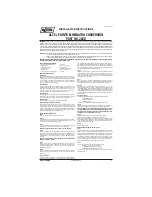
U.S. DOT Tire Identification Number (TIN)
A tire's serial number. It begins with the letters “DOT” (“Department of Transportation”) and indicates
that the tire meets all federal standards. The next 2 numbers or letters indicate the plant where the tire
was manufactured. The last 4 numbers represent the week and year of manufacture.
For example, the numbers 1709 mean that the tire was produced in the 17th week of 2009. Any other
numbers are marketing codes used by the tire manufacturer. This information is used to help identify
affected consumers if a tire defect requires a recall.
Vehicle capacity weight
The total rated cargo, luggage and passenger load. Passenger load is 150 lbs (68 kilograms) times the
vehicle's total seating capacity (as listed on the label inside the driver door).
Vehicle maximum load on the tire
The load on an individual tire that is determined by taking each axle's share of the maximum loaded
vehicle weight (GAWR) and dividing by 2.
Vehicle normal load on the tire
The load on an individual tire that is determined by taking each axle's share of the curb weight,
accessory weight, and normal occupant weight (distributed according to the table below) and dividing
by 2.
Wheel size designation
Wheel rim diameter and width.
Occupant loading and distribution for vehicle normal load for various designated seating
capacities
Designated seating capacity,
number of occupants
Vehicle normal load, number
of occupants
Occupant distribution in a
normally loaded vehicle
2, 3, or 4
2
2 in front
5
3
2 in front, 1 in back
Tires and vehicle load limits
¤
Please first read and note the introductory information and heed the WARNINGS
There are limits to the load any vehicle or any tire can carry. A vehicle that is overloaded will not
handle well and is more difficult to stop. Overloading can damage important parts of the vehicle.
Overloading can also lead to blowout, sudden loss of pressure or other tire failure that can cause loss
of control.
Your safety and the safety of your passengers depends on making sure that load limits are not
exceeded. Vehicle load includes everybody and everything in and on the vehicle. These load limits are
technically referred to as the vehicle's
Gross Vehicle Weight Rating (GVWR)
.
The GVWR includes the weight of the basic vehicle, all factory-installed and other accessories, a full
tank of fuel, oil, coolant and other fluids plus maximum load. The maximum load includes the number
of passengers that the vehicle is intended to carry (seating capacity) with an assumed weight of
150 lbs (68 kg) for each passenger at a designated seating position and the total weight of any
luggage in the vehicle. If you tow a trailer, the weight of the trailer hitch and the tongue weight of the
loaded trailer must be included as part of the vehicle weight. At altitudes above 3000 ft (1000 m),
combined towing weight (vehicle plus trailer) must be reduced by 10% for every 3000 ft (1000 m).
Содержание 2015 Golf GTI
Страница 69: ......
















































